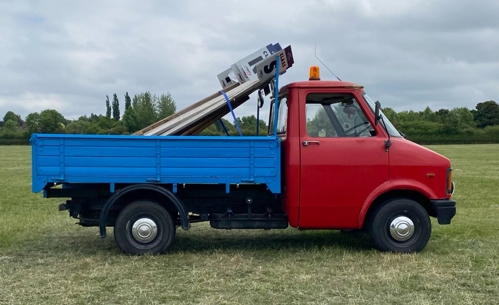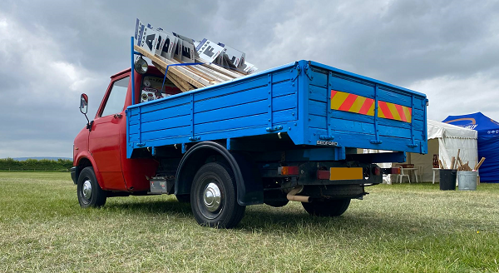MEET THE OWNER – HARRY SEAGER AND HIS BEDFORD CF PICK-UP
16 June 2025
“It is great fun - quite quick for what it is, and the turning circle is rather incredible. It turns more heads than any other car I have”. I recently described the many delights of the Chiltern Hills Rally, and one of my first blogs on its exhibits focuses on Harry Seager’s 1982 Bedford CF1 ‘Facelift’ Pick-Up. When the world was young, and Peter Clark presented Southern Television’s Crime Desk, the CF was part of the fabric of my everyday life, be it as an ice cream van dispensing 99 flakes, a Rediffusion delivery van containing the latest in rental colour television sets or a school mini-bus embarking on a thrilling educational trip to the local cardboard box factory.

Bedford launched the CF in August 1969 after 17 years and 370,045 examples of the CA. Its principal domestic rivals were the BLMC J4 and J2, the Commer ‘Spacevan’ and, in particular the Ford Transit. Since October 1965, the “tradesmen’s choice” had virtually re-defined the light commercial vehicle sector. By the following year, Luton responded with plans for a CA rival. The not exactly subtle sales copy claimed, “The CF is built to last any opposing force” – i.e. especially those forces hailing from Langley and, slightly later, Southampton.
The original 25-strong model line-up included a choice of two wheelbases, five payloads, and diesel or petrol engines, the latter being 1.6-litre and 1.8-litre’ Slant Four’ OHC units. “If you’re looking for a long service van, and one that merits good conduct medals galore - come and inspect the new CF Brigade at your Bedford dealer”. In 1969, many potential fleet buyers would have been either WW2 veterans or former National Servicemen. Unlike the Transit, the CF had independent front suspension, and dealers could further highlight its rack & pinion steering.
When Ford introduced the Transit Mk. II in 1978, Bedford responded in 1979 with a facelifted CF. Harry’s Pick-Up has better seats and a much-improved dashboard, including fresh air vents. By 1981, Commercial Motor reported that the CF range accounted “for 44 per cent of the company’s total production”. Alas, Bedford had not made a profit since 1979, but four years later, they announced the mechanically improved CF2 in the hope of attracting Transit owners.
By the end of 1982, Bedford was no longer a division of Vauxhall but part of the General Motors Overseas Commercial Vehicle Corporation. There were plans for a partnership with British Leyland on a joint CF2/Sherpa replacement planned for a 1988 launch. However, the ‘World Van’ project eventually collapsed.

In 1985, the Isuzu Fargo-based Bedford Midi seemed to mark the CF2’s imminent demise. The company’s former MD, J.T. Battenburg, had already told the press that Japanese designs:
Offered a reduction in lead times beyond anything we could get with other products. We wanted to get as many vehicles through the dealerships as we could — so I don’t think there is anything sinister, nor is there necessarily any directive (from GM). It’s a good business decision — they provided us with the solution to our short-term needs.
CF2 production ceased in late 1986, marking the end of wholly British-designed Bedford vans. Commercial Motor of the 23rd of July 1987 announced “End of the road for CF2: “The final chapter in the story of Bedford’s CF van appears to be drawing to a close with the news that the company is to cease production of the 2.3-3.5-tonne CF2 van and chassis cab range at the end of the month”. They further reported:
Bedford, currently embroiled in the details of its life-saving venture with the Japanese manufacturer Isuzu (CM 2 May), will offer only a terse ‘no comment’, but a number of Bedford
dealers say they have been notified by GM that no more CF2s will be built after the end of July.
One dealer said, “GM stopped taking orders for the CF ‘some time ago’, and that it has been difficult to get hold of chassis cabs for a number of months”.

It was a rather sad demise for a respected family of vans and pick-ups and a Bedford tradition of light commercial vehicles. If the CF did have a fault, it was one shared with its original BLMC and Commer rivals - responding to the Transit after a long head start by Ford.
Today, Harry uses his CF very much as a working vehicle. “It is probably driven two to three times a month and used to move personal items around or help friends out. It was actually used to help clear the show site on the Monday!” As for how Harry acquired his Bedford:
I have always wanted one, and this CF came up ridiculously well-priced and locally right on the fringes of Lockdown. The Bedford had been on someone’s driveway for some time, and it ended up being a Lockdown project - and continues to be a project! My tasks included bits of paintwork, bits of wiring, and interior work. There was also a new front bumper powder coated and fitted, riveted digit number plates, a replacement rear bed with new wood and a new H-frame. I redid all the wood with decking, added tie-down points, and installed ‘rear work lights’. I fitted front spotlights and an array of cheesy, period stickers on the back window in an attempt to make the CF look like something a tradesman at the time may have done.
Harry additionally fitted “a cassette radio with Bluetooth”, so he can listen to the Complete Madness album as the CF travels the mean streets of Aylesbury.
The usual comments Harry receives are “mostly about how it’s great to see one, as mostly camper vans, ice cream vans and things survive, but not so many flatbed trucks”. And such responses are only to be expected with a Bedford offering “Comfort with practicality”.
With thanks to Harry Seager for his time.
With thanks to Harry Seager for the permission to use the images in this blog.
